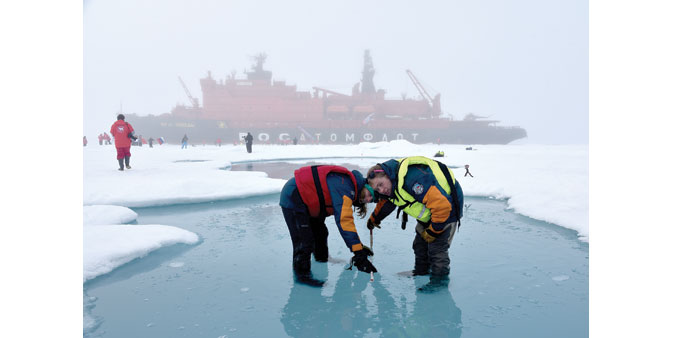AT WORK: Scientists Annette Bombosch, left, and Alex Cowan, right, measure a melt pond on the ice sheet at the North Pole.
By Ulf Mauder
It took 100 excited tourists to get German marine biologist Annette Bombosch to the North Pole. She and other budget-conscious scientists tagged along on with a sight-seeing cruise on a Russian ice-breaker to see what’s troubling the climate and wildlife in the Arctic Sea.
“The ice is an important ecosystem for polar bears, walruses and other species and it is changing rapidly. The melting ice from global warming deprives them of a crucial habitat,” said Bombosch, 32.
She travelled to the Pole on the 50 Let Pobedy (50 Years of Victory), a nuclear-powered vessel that displaces 25,000 tons.
Chartered from the Russian nuclear authorities by the Poseidon cruise line for 52,000 euros a day, the giant ship crashed through metre-thick ice to bring the large group of sightseers and handful of researchers to the top of the Earth in the northern summer.
The biologist and her colleagues earned their keep by giving lectures to passengers from 21 countries on the five-day outward voyage before they could get down to business.
With the Arctic now heating up twice as fast as other parts of the globe, Bombosch, formerly of Germany’s Alfred Wegener Institute for Polar Research, warns against ever greater hazards for the delicate ecological balance.
“There is also ocean acidification, which is harmful for calcium carbonate skeleton organisms,” she says, referring to the ongoing decrease in the pH of the Earth’s oceans, caused by the uptake of carbon dioxide (CO2) from the atmosphere, a process that is magnified in polar conditions.
“Cold water especially absorbs carbon dioxide, becomes acidic and so destroys calcium carbonate skeletons,” Bombosch says. This threatens many animals like mussels or snails that are essential to the food chain and sustenance of larger denizens of the Arctic like polar bears and walruses.
Above all, plans of Russia and other countries to expand operations to extract huge reserves of oil and gas in the region’s seabed cause concern, and not just because of the risks of pollution from spillage. Noisy production platforms and increasing container ship traffic can massively disrupt communication among whales and their search for feeding grounds, warns the biologist.
Bombosch, who has a doctorate in whale research, saw plenty of polar bears on the voyage, but also bowhead whales, Balaena mysticetus, which are a rarity in the Barents Sea.
“We record these sightings and send them to Arctic research institutes so they can be collated into sightings maps in international databases,” she says.
Two polar research colleagues on the icebreaker, Briton Alex Cowan and American Lauren Farmer, used the voyage to gather data for a research project on the composition and strength of sea ice. Working also directly at the North Pole, the team for the University of Alaska in Fairbanks is studying the size and depth of melt ponds that form on the ice and freeze over again in early autumn.
“We complement the data gathered by satellite and by hand at the site,” says Farmer, who gauges the thickness of the floes using the measuring line painted on the side of the hull as the ship crashes through the ice.
From helicopters the scientists also gain an overview of the ice carpet, which is full of holes and cracks and dotted with the melt ponds. Seen as bright blue blobs on a white sheet, the ponds show that the ice layer in these locations is two to three years old, while darker spots indicate fresh and thin ice, Farmer says.
The project looks at how the ice melts in the warmer months, breaks up and forms again, and how the Arctic Ocean absorbs the sun’s heat and light, because the melt ponds absorb much more heat than the ice around them.
2012 was the summer with the least ice since the study began, the researchers say. The consequences are dire, because many micro-organisms and small fish that feed the larger animals live beneath the ice. Polar bear are especially now drawn in larger numbers to the islands when their icy hunting ground vanishes.
The geologist Cowan sees the cause of the massive ice melt in the emission of greenhouse gases that heat up the atmosphere. There are now fears that the Arctic Ocean could be ice-free in the summer within the next few decades — around 2040.
Meanwhile, the cruise passengers who pay 27,000 euros apiece for this trip of a lifetime, also help the scientists measure and collect data. Cowan advocates involving polar tourists more intensely in scientific surveys.
“I think there is a market for research cruises,” he says, adding that the scientific community alone cannot afford the high costs of mounting such expeditions. But if tourism is more involved, says the Briton, then databases can be developed to give early warning of changes at the poles.
However, this may have been the last tourist voyage of the 50 Let Pobedy. Moscow is said to have now assigned this and Russia’s other icebreakers to the exclusive task of clearing the sea lanes to the oil and gas installations, and expanding the northern shipping routes for container traffic from Asia to Europe. —DPA

